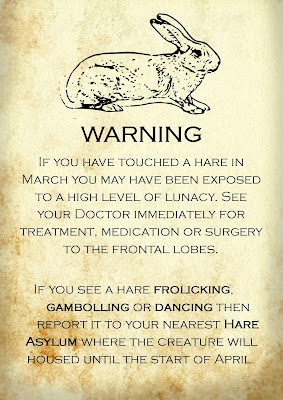 |
| Signs like this were often seen on the streets of Bridgewater and Halifax (that housed the most prominent Hare Asylums). |
The first Hare Asylum; The Saint Francis of Assisi Lepus Sanitorium was set up by a group of monks in 1752 in York. It was long considered that the actions of hares in the month of March were not only damaging to the morals of good Christian folk but the also were potentially infectious.
For this reason it was considered prudent that all hares were incarcerated in specially made asylums from the first to the thirty first of March.
 |
| This poem was used to raise funds for the hare asylums. The text points to the problems associated with the Mad March syndrome. |
1. Hares were placed in a room on their own for an hour a day. In the room was a hatch through which a Nun would sing three hymns (repeating them once complete).
2. All hares were forcibly baptised.
3. Male hares (bucks) were given bowls of ale to drink to control libido.
4. Female hares (does) were trained in courting and dining etiquette.
5. Hares that followed their breeding instinct were chastised and the book of Job read to them in its entirety.
For more information about Hare Asylums we heartily recommend "The Truth About Hare Asylums". (Out of Print)











